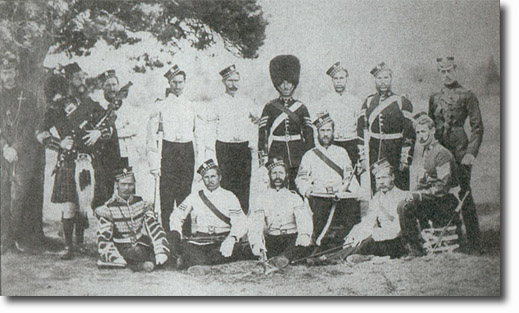|
|

 |
|
Several of the group are wearing the white drill or fatigue jacket that was worn until the early years of the 20th century. The garment is descended from the waistcoat that was worn under the coat in the 18th century. This used to be exposed when the coat was worn open, but when in 1800 the coat was buttoned up the waistcoat was retained for informal barrack work. Most regiments discontinued this jacket, but the Guards and Highland regiments carried on wearing it. A new pattern was introduced in 1907 but it was laid aside for the duration of the Great War. It re-emerged after the war and was last worn in 1933. The rank chevrons were white on red cloth at this stage, gold on red for sergeants and above. Up until c1870 the chevrons were black.
The peakless forage cap is still slightly bell-topped. By 1780 it had become more of a pill-box shape. There is still a chin-strap on the NCOs' forage caps but not on the officer's peaked cap. He stands on the right, wearing a frockcoat. At the other end of the group is the Pipe-Major in full dress. At his feet is a corporal drummer from the Corps of Drums with his bugle. Two standing NCOs are wearing the full dress tunic with star badges on the collar. The new 1871 equipment has not been issued yet so they still wear their ammunition pouch attached to a shoulder belt. |
Armed Forces | Art and Culture | Articles | Biographies | Colonies | Discussion | Glossary | Home | Library | Links | Map Room | Sources and Media | Science and Technology | Search | Student Zone | Timelines | TV & Film | Wargames